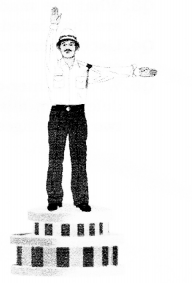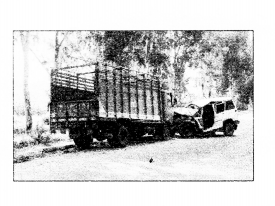Rajasthan Board RBSE Class 9 Science Notes Chapter 16 Road Safety Education
Motion and Time:
- Equations of motion are the base to study the causes of accidents. With the help of equation of motion, we can easily
- calculate the stopping distance and distance for safe driving.
- The speed of vehicle should be as such that if any object is spotted on the road, the vehicle can be stopped immediately.
- The vehicle before going to stop, covers a reaction distance and breaking distance. Reaction distance is that distance which is covered before retardation, when driver feels danger and retardation distance is the distance covered by the vehicle between the retarding motion and before coming to rest

Calculation of Reaction Distance:
The time taken to cover the reaction distance is normally 0.6 sec to 1 sec, which depends upon the physical and mental position, as well as alertness of the driver.
For example:
Reaction time = 1 second;
Speed in km/h = 10 km/h = \(\frac{10 \times 1000}{60 \times 60}=\frac{25}{9} \mathrm{m} / \mathrm{s}\)
Reaction distance = Speed × Time = \(\frac{25}{9} \times 1\) = 2.77 m = Approximately 3 meter
Calculation of Breaking Distance:
The breaking distance depends upon the following factors:
- Road conditions
- Whether
- Conditions of tyres and brakes
- In normal conditions of road and good condition of brakes, the retardation generate at the rate of 4.4 m/s².
Final velocity (v) = 0
Initial velocity (u) = 10 km/h = \(10 \times \frac{5}{18}=\frac{25}{9} \mathrm{m} / \mathrm{s}\)
Retardation (a) = – 4 .4 m/s²
According to equation of motion
v² – u² = 2as
\(0-\left(\frac{25}{9}\right)^{2}\) = \(2 \times(-4.4) \times \mathrm{s}\)
S= \(\frac{625}{81} \times \frac{1}{8.8}\) =
⇒ Braking distance = 0.88 m ~1m
Total distance covered by the body, when it comes to rest
= Reaction distance + Breaking distance
= 3m + 1m = 4m
Causes of Road Accidents:
- Excessive speed and rash driving,violation of traffic rules, carelessness, fatigue, alcohol, sleep etc.
- Defects in vehicles, such as failure of brakes, tyre burst, lighting system.
- Due to road conditions like skidding road surface, pot holes etc.
- Environmental factors such as weather conditions, like mist, snow, smoke and heavy rainfall, which restrict normal visibility and makes driving unsafe.
- For over speed driving, there is a provision of punishment, according to motor vehicles act section 112-183 under which either the driver will pay the fine or have to be imprisoned for 6 months.

FORCE:
- While driving a car or any other four wheeler, wearing a seat belt is compulsory, not only for those who is driving the car and sitting on the front seat, but those who are sitting at the back seat too. In fact all the people riding a car should wrap a seat belt for their own safety. When you apply brake all of a sudden, if you are not wearing a seat belt, your face is bound to hit against the wind shield. The seat belt stops this inertia.
- The seat belt when worn in proper order in normal driving posture can keep you seated, no matter how hard the impact is. There are many accidents where the driver is thrown out of the car and these accidents can be deadly. When you remain seated, the injuries are bare accidents minimum. Air-bags are an added security feature, in all the modern cars.
- They are released when there is a collision and protect the driver from banging hard against the stirring wheel. But, if you do not wear the seat belt, then the effectiveness of air bags is minimized. „
- Most accidents took place on the highway, due to dim-light, no divider on roads, no speed breakers on road; over taking of vehicles, no zebra crossing etc. On a wet road there is more chances of accidents. In hilly areas, mostly accidents are due to brake- failure.
- As you know, when the car is moving on the ascent of the hill, then speed of car will decrease. Therefore, the brakes should be in healthy working conditions. If we want to park the vehicle on hilly areas then we must use hand brakes. Vehicle remain in its position, when friction is generated due to treads on tyre. Tyre inflation pressure should be appropriate there.
WORK AND ENERGY:
- The aim of this lesson is to understand the mutual relationship of momentum and Kinetic energy, and the conclusion drawn on the effect in relation between mass and velocity, when two objects are in the state of collision.
- Work: Work is done when a force acting on a body produces displacement in it. The S I. unit of work is newton meter (N m) or Joule (J).
- Energy: The capacity of a body to do work is called its energy. The S.l unit of energy is Joule (J).
- Amount of energy possessed by a body = Amount of work it can do
- Kinetic Energy: Energy possessed by a body by virtue of its motion is called its kinetic energy.
A Kinetic Energy = 1/2 mv²
where, m is the mass of body and v is the velocity of the body. - Potential Energy: Energy possessed by a body by virtue of its position or shape is called Potential energy. Potential energy of a body by virtue of its height from the ground is called gravitational potential energy.
Gravitational potential energy = mgh - Momentum: Momentum is defined as product of mass and its velocity.
Momentum of a body = Mass of the body x Velocity of the body
p = mv - If a light and a heavy object have the same momentum, then kinetic energy of the light object will be greater than the kinetic energy of the heavy object.
- Collision is a process in which two or more than two vehicles collide with each other. There are two type of collision:
- Elastic collision
- In elastic collision
SOUND:
- Due to large number of vehicles on the road, the noise pollution is increased by.the set limit. The main purpose of this chapter is to give information to the student, about the cause and effects of the noise pollution etc.
- Noise is defined as the unwanted, unpleasant or disagreeable sound that causes discomfort to all living beings. Sound intensity is measured in decibels (dB) that is the tenth part of the longest unit, Bel. One dB is the faintest sound that a human ear can hear.
- In the city, the main source of traffic noise are the motors and exhaust systems of autos, smaller trucks, buses and motorcycles. The noise from the construction of nearby buildings, especially when the building is not well designed and constructed are very disturbing. In this case, internal building noise from plumbing, boilers generators can be audible and annoying. Sometime, noise pollution came from consumer products, such as kitchen appliances, vacuum cleaners even though their contribution to daily noise dose is usually not very large.
The effects of Noise pollution on human being, animals and property are as follows:
- Decreases the efficiency of a man.
- Lack of concentration.
- Fatigue.
- Abortion.
- It causes blood pressure.
- Temporary or permanent Deafness.
- Effect on vegetation.
- Effect on animals etc.
No horn Zone Areas:
- No horn zone areas are nearby hospitals, school government offices and religious places.
- A loud speaker or a public address system shall not be used, except after taking written permission from the authority and the same shall not be used at night, between 10 P.M. to 6 A.M.
- A person found violating the provisions as to the maximum noise permissible in any particular area, shall be liable to be punished for it, as per provision of these rules and any other law in force.